
Athyma selenophora, the staff sergeant, is a species of nymphalid butterfly found in tropical and subtropical Asia.

Hebomoia glaucippe, the great orange-tip, is a butterfly belonging to the family Pieridae, that is the yellows and whites. It is found in the Indomalayan realm and Wallacea.

Euchrysops cnejus, the gram blue, is a small butterfly that belongs to the lycaenids or blues family. It is found from India to Australia. The species was first described by Johan Christian Fabricius in 1798.

Anthene emolus, the ciliate blue, is a small butterfly found in India and southeast Asia that belongs to the lycaenids or blues family. The species was first described by Jean-Baptiste Godart in 1823.

Hypolimnas misippus, the Danaid eggfly, mimic, or diadem, is a widespread species of nymphalid butterfly. It is well known for polymorphism and mimicry. Males are blackish with distinctive white spots that are fringed in blue. Females are in multiple forms that include male-like forms while others closely resemble the toxic butterflies Danaus chrysippus and Danaus plexippus.
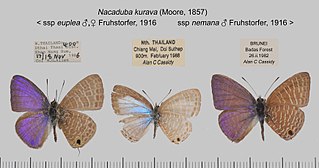
Nacaduba kurava, the transparent six-line blue, is a Lycaenidae butterfly found in Asia and Australia. The species was first described by Frederic Moore in 1857.
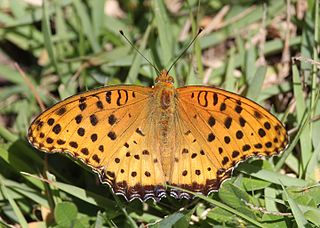
The Indian fritillary is a species of butterfly of the nymphalid or brush-footed family. It is usually found from south and southeast Asia to Australia.

Ionolyce helicon, the pointed lineblue, or bronze lineblue, is a small butterfly found in the Indomalayan realm that belongs to the lycaenids or blues family.
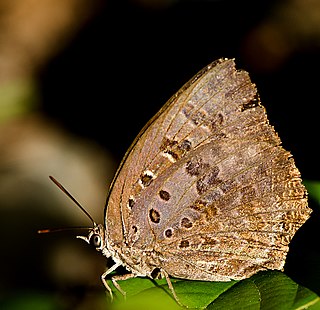
Arhopala amantes, the large oakblue, is a species of lycaenid or blue butterfly found in Asia.
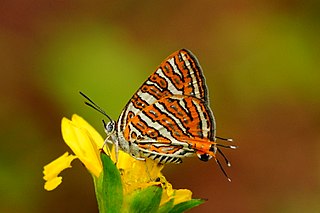
Cigaritis vulcanus, the common silverline, is a species of lycaenid or blue butterfly found in Asia. It was first described by Johan Christian Fabricius in 1775.
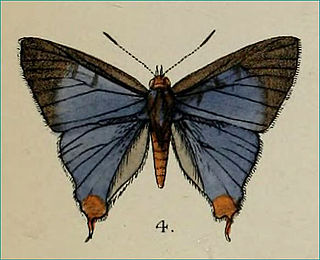
Cigaritis abnormis, the abnormal silverline, is a species of lycaenid or blue butterfly found in south India and Pakistan.

Zesius chrysomallus, the redspot, is a species of lycaenid or blue butterfly found in Sri Lanka and India.

Tajuria jehana, the plains blue royal, is a species of lycaenid or blue butterfly found in Asia.

Horaga onyx, the common onyx, is a species of lycaenid or blue butterfly found in Asia.

Rapala varuna, the indigo flash, is a species of lycaenid or blue butterfly found in the Indomalayan realm and the Australasian realm.
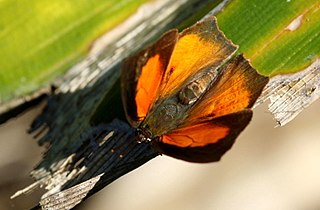
Curetis acuta, the angled sunbeam, is a species of butterfly belong to the lycaenid family. It is found in Indomalayan realm. Curetis acuta is sexually dimorphic due to the different dorsal coloration of the wings between the sexes, however their ventral wings are similar and of silver color which reflects sunlight. The reflection of light by silver ventral wings plays a role of signalling during flight, camouflage while at rest or during hibernation, and lowering body temperatures by reflecting the sunlight.

Eutelia geyeri is a moth of the family Noctuidae first described by Rudolf Felder and Alois Friedrich Rogenhofer in 1874. This species is found in India, Sri Lanka, China and Japan, as well as from Africa, where its presence had been reported from Lesotho and Seychelles.
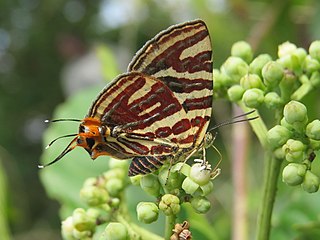
Cigaritis lohita, the long-banded silverline, is a species of lycaenid or blue butterfly.
Leucoblepsis neoma is a moth in the family Drepanidae. It was described by Swinhoe in 1905. It is found in Singapore and on Peninsular Malaysia, Sumatra and Borneo.
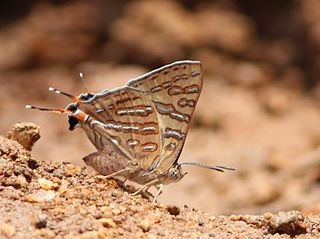
The Common shot silverline, Cigaritis ictis, is a species of lycaenid butterflies. It is native to India and Sri Lanka. The Sri Lankan population is classified as a subspecies: Cigaritis ictis ceylonica(Felder, 1868).

















